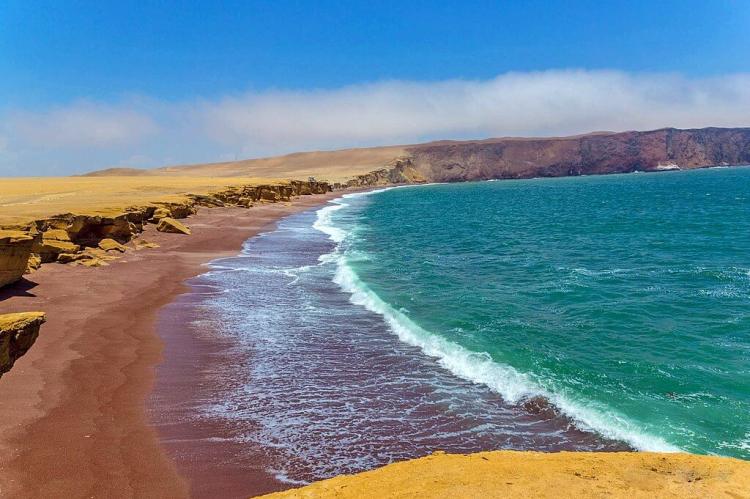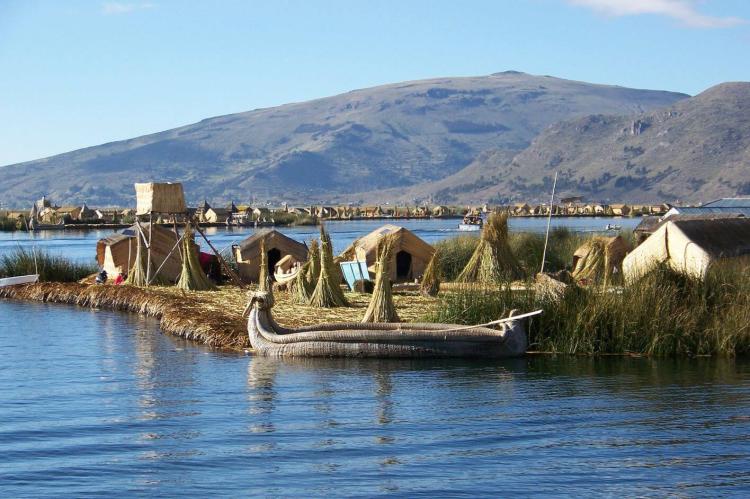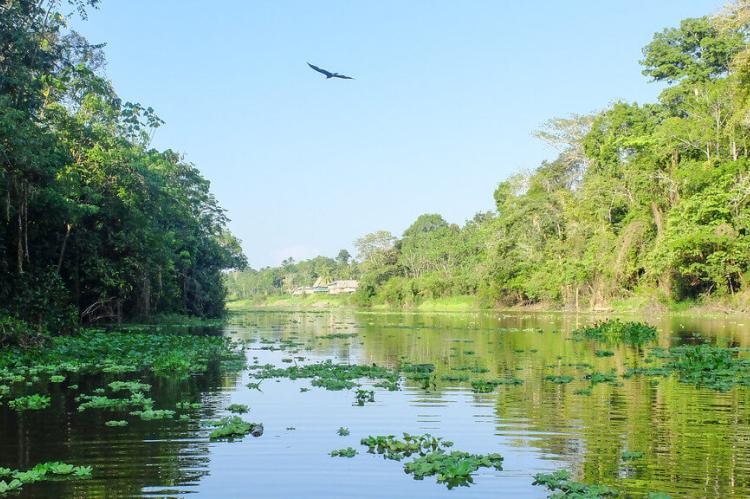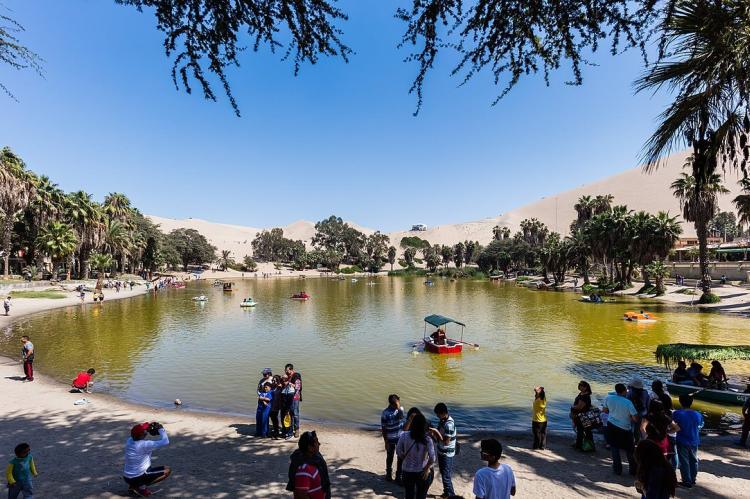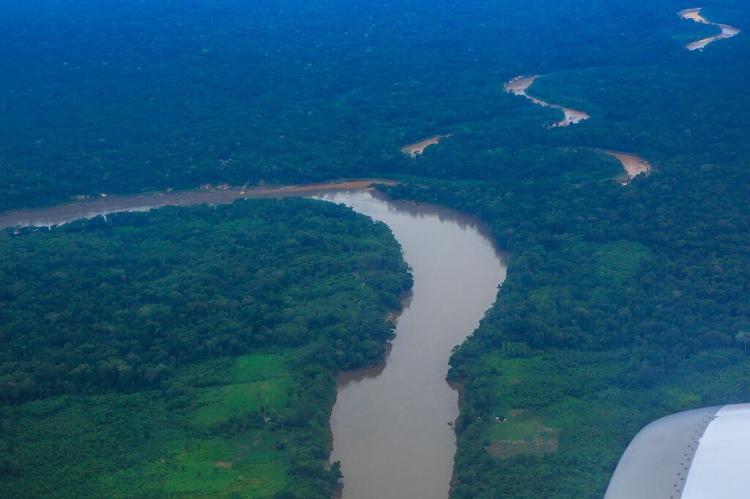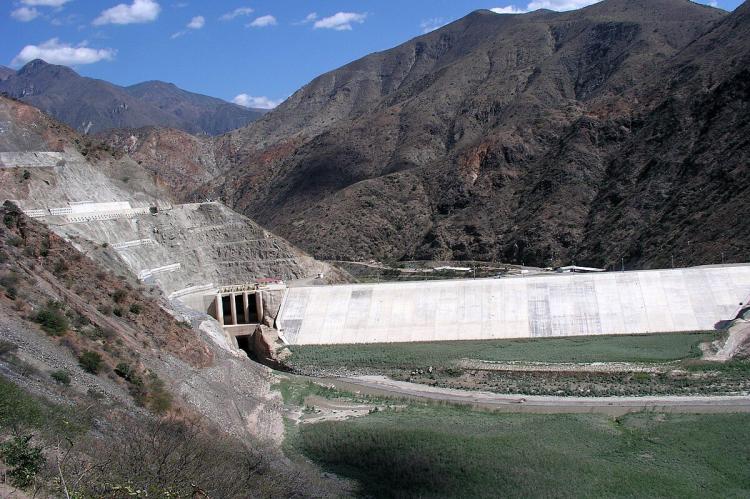Water Bodies of Peru
Peru, a land of striking geographical diversity, is adorned with an impressive tapestry of water bodies that sculpt its terrain and imbue its inhabitants' lives with vitality. Beyond ecological significance, they are repositories of cultural heritage and the source of spiritual reverence and artistic inspiration.
Water Bodies of Peru
Peru, a land of striking geographical diversity and storied cultural heritage, is adorned with an impressive tapestry of water bodies that sculpt its terrain and imbue its inhabitants' lives with vitality.
Among these natural wonders stand the mighty Amazon River, whose sinuous course cuts through dense rainforests, teeming with biodiversity; Lake Titicaca, nestled serenely amidst the Andean peaks, its crystalline waters reflecting centuries of indigenous traditions; and the Pacific Ocean, whose azure expanse kisses Peru's western coastline, shaping its maritime history and economic prosperity.
These waterways are not mere geographical features but lifelines that sustain ecosystems, support livelihoods, and shape Peru's identity. With its unparalleled biodiversity, the Amazon is a sanctuary for countless species and a source of sustenance for indigenous communities living along its banks. Lake Titicaca, the world's highest navigable lake, is a sacred site for Andean cultures, a cradle of ancient civilizations, and a vital resource for agriculture and fisheries. Meanwhile, with its bountiful marine life, the Pacific Ocean fuels Peru's thriving fishing industry and beckons adventurers to its sun-kissed shores.
Beyond their ecological significance, these water bodies are repositories of cultural heritage woven into the fabric of Peru's history and traditions. They are the settings for ancient myths and legends, the source of spiritual reverence, and the inspiration for artistic expression. Whether through traditional fishing practices on the Amazon, ceremonial offerings on Lake Titicaca, or coastal festivals celebrating the ocean's bounty, water plays a central role in Peruvian culture, connecting communities across vast distances and generations.
Gulfs, Bays, and Coastal Lagoons
These gulfs, bays, and coastal lagoons in Peru contribute to the country's ecological diversity, provide valuable habitats for wildlife, and offer opportunities for tourism and recreational activities. They are essential parts of Peru's coastal ecosystems and play a significant role in supporting local communities and preserving biodiversity.
Gulfs and Bays
Gulf of Guayaquil (Golfo de Guayaquil): Located in northern Peru, the Gulf of Guayaquil is a large and significant body of water shared with Ecuador. It opens into the Pacific Ocean and is an important maritime route for international trade and fishing activities.
Sechura Bay (Bahía de Sechura): Sechura Bay is located on the northwest Pacific coast of Peru. It is a highly productive bay due to its nutrient-rich coastal upwelling, warm waters, and large banks of shallow scallop habitat. Sechura is historically a fishing region and is the most critical location for producing the Peruvian bay scallop.
Bay of Paracas (Bahía de Paracas): Found on the southern coast of Peru, the Bay of Paracas is part of the Paracas National Reserve, a protected area famous for its stunning landscapes and abundant marine life. The bay is a popular destination for wildlife and water sports enthusiasts alike.
Bay of San Juan (Bahía de San Juan): Located in the region of Piura in northern Peru, the Bay of San Juan is known for its beautiful beaches and is a significant fishing area for local communities.
Bay of Chimbote (Bahía de Chimbote): Situated along the central coast of Peru, the Bay of Chimbote is an important fishing and industrial hub known for its rich marine resources and active port.
El Ferrol Bay (Bahía El Ferrol): Located in the Tumbes Region, El Ferrol Bay is a haven for birdwatchers. It is home to several bird species and hosts the Manglares de Tumbes National Sanctuary.
Coastal Lagoons
Chala Lagoon (Laguna de Chala): Located near the town of Chala in southern Peru, this coastal lagoon offers a picturesque setting and supports a variety of bird species, making it a popular spot for birdwatching.
Ñapique Lagoon (Laguna Ñapique): Situated in the Tumbes Region of northern Peru, the Ñapique Lagoon is a tranquil freshwater lagoon surrounded by lush vegetation, providing habitat for diverse wildlife.
Lagoons of Mejía (Lagunas de Mejía): Situated in the Arequipa Region, the Lagoons of Mejía are a complex of coastal lagoons and wetlands that serve as essential habitats for migratory birds.
Lagoons of Pacocha (Lagunas de Pacocha): Found in the Moquegua Region, the Lagoons of Pacocha are a series of coastal lagoons that provide essential habitats for birds and other wildlife.
Guanape Lagoon (Laguna Guanape): In the La Libertad Region, Guanape Lagoon is a coastal wetland that supports various bird species and provides a peaceful environment for nature enthusiasts.
Lagoons of Villa (Lagunas de Villa): Situated near Lima, the Lagoons of Villa are a series of coastal lagoons that form part of the Villa Marshes Natural Reserve. They are important habitats for migratory birds and offer opportunities for birdwatching.
Notable Lakes and Inland Lagoons
Peru's notable lakes and inland lagoons form a captivating tapestry of natural wonders, each contributing to the country's ecological diversity and cultural heritage. They offer visitors and researchers unique opportunities to explore and appreciate Peru's diverse landscapes and ecosystems.
Lake Titicaca (Lago Titicaca): Lake Titicaca is one of the most iconic and significant lakes in Peru and the highest navigable lake in the world. Straddling the border between Peru and Bolivia, it is steeped in cultural significance for the Andean people. The deep blue waters of Lake Titicaca are dotted with several islands, including the floating Uros Islands made of reeds. The lake is a natural wonder, a vital water resource, and a habitat for unique flora and fauna.
Lake Junín (Lago Junín): Located in the Junín Region of central Peru, Lake Junín is the country's second-largest lake and an essential part of the Junín National Reserve. The lake's shallow waters support diverse bird species, making it a prime spot for birdwatching. It is also critical in regulating the region's climate and acts as a natural reservoir.
Lake Huacarpay (Lago Huacarpay): Situated in the Cusco Region of southern Peru, Lake Huacarpay is a Ramsar Wetland of International Importance, recognized for its ecological significance. The lake and surrounding wetlands provide an essential habitat for migratory birds and other wildlife habitat.
Lake Parón (Lago Parón): Located in the Ancash Region, Lake Parón is one of the highest lakes in Peru, nestled amidst the stunning Cordillera Blanca mountain range. The turquoise waters of Lake Parón, fed by glaciers, create a picturesque setting, attracting trekkers and nature enthusiasts.
Lake Huaypo (Lago Huaypo): Found near Cusco, Lake Huaypo is a tranquil and scenic lake surrounded by picturesque Andean landscapes. It offers opportunities for fishing, kayaking, and enjoying the serenity of nature.
Lake Huamantay (Laguna Humantay): Situated in the Cusco Region, Lake Huamantay is known for its striking turquoise waters. Nestled at the base of the snow-capped Humantay Mountain, the lake is a popular destination for hikers exploring the Salkantay Trek to Machu Picchu.
Lake Sandoval (Lago Sandoval): Located within the Tambopata National Reserve in the Madre de Dios Region, Lake Sandoval is a beautiful oxbow lake home to abundant wildlife, including giant river otters, macaws, and monkey species. It is a key attraction for eco-tourists exploring the Amazon rainforest.
Lake Llanganuco (Lago Llanganuco): Situated in the Huascarán National Park in the Ancash Region, Lake Llanganuco is a glacial lake known for its crystalline waters and stunning mountain views. The lake's surroundings offer numerous hiking opportunities.
Lake Cashibococha (Lago Cashibococha): Located in the Loreto Region in northeastern Peru, Lake Cashibococha is part of the Pacaya-Samiria National Reserve, the largest protected flooded forest in the country. The lake is an essential habitat for aquatic species and supports local communities' fishing activities.
Lake Rimachi (Lago Rimachi): Situated in the Puno Region of southern Peru, Lake Rimachi is known for its stunning landscapes and unique rock formations. It provides a serene setting for visitors seeking tranquility.
Lake Ichu (Lago Ichu): Located in the Puno Region, Lake Ichu is a small lake surrounded by reed beds and high-altitude wetlands. It offers refuge to various bird species.
Lake Cabanaconde (Lago Cabanaconde): Located in the Arequipa Region, Lake Cabanaconde is a volcanic crater lake in the Colca Canyon region. The lake is surrounded by breathtaking scenery and is an excellent spot for nature enthusiasts and hikers.
Lake Chinchaycocha (Lago Chinchaycocha): Lake Chinchaycocha is a glacial lake near the Huascarán summit in the Ancash Region. It is part of the Huascarán National Park and is surrounded by snow-capped peaks and impressive glaciers.
Lake Pumacocha (Lago Pumacocha): In the Cusco Region, Lake Pumacocha is known for its clear waters and picturesque setting, making it a popular spot for photography and relaxation.
Lake Pomacanchi (Lago Pomacanchi): In the Cusco Region, Lake Pomacanchi is a beautiful freshwater lake surrounded by rolling hills and farmland. It is an ideal spot for fishing and boating.
Lake Cochapata (Laguna Cochapata): Found in the Junín Region, Lake Cochapata is a high-altitude lake surrounded by Andean landscapes, making it a picturesque destination for nature enthusiasts.
Lake Yanacocha (Laguna Yanacocha): Located in the Ancash Region, Lake Yanacocha is a small but picturesque lake that offers views of the surrounding snow-capped peaks.
Lake Choclococha (Laguna Choclococha): Situated in the Huancavelica Region, Lake Choclococha is a large and deep lake known for its stunning blue color. High-altitude grasslands surround it and are an essential water source for the region.
Lake Huacachina (Laguna de Huacachina): Not far from the city of Ica, Lake Huacachina is an oasis lagoon nestled amid towering dunes and has become a popular tourist destination for sandboarding and dune buggy rides.
Lake Morón (Laguna Morón): Located in the Cajamarca Region, Lake Morón is a scenic lake surrounded by rolling hills and agricultural lands, offering a peaceful setting for visitors.
Lake Yanahuaya (Laguna Yanahuaya): In the Puno Region, Lake Yanahuaya is a small lake known for its picturesque location and birdwatching opportunities.
Lake Ccoricocha (Lago Ccoricocha): In the Cusco Region, Lake Ccoricocha is a glacial lake nestled amidst the Andean mountains, offering captivating views for trekkers.
Lake Patarcocha (Laguna Patarcocha): Located in the Huánuco Region, Lake Patarcocha is a scenic high-altitude lake surrounded by picturesque landscapes.
Lake Pumaqucha (Lago Pumaqucha): In the Cusco Region, Lake Pumaqucha is a beautiful lake near the Salkantay Trek trail, offering breathtaking views of the surrounding mountains.
Lake Chuspicocha (Lago Chuspicocha): In the Puno Region, Lake Chuspicocha is a small lake surrounded by stunning Andean scenery.
Lake Pariacaca (Lago Pariacaca): Located in the Junín Region, Lake Pariacaca is known for its cultural significance and stunning views of the Pariacaca Mountain.
Lake Jahuacocha (Laguna Jahuacocha): Situated in the Huascarán National Park in the Ancash Region, Lake Jahuacocha is a glacial lake offering mesmerizing views of the surrounding peaks.
Lake Sibinacocha (Laguna Sibinacocha): Located in the Cusco Region, Lake Sibinacocha is a large glacial lake situated at a high altitude, surrounded by the Vilcanota mountain range.
Lake Mallku Quta (Lago Mallku Quta): Located in the Puno Region, Lake Mallku Quta is a high-altitude lake with pristine waters that provide habitat for various bird species.
Lake Aricoma (Lago Aricoma): Lake Aricoma is a lake in the Peruvian Andes. Situated in the Puno Region, the lake lies west of the mountains Aricoma and Jalahuana and east of the lake Veluyoc Cocha.
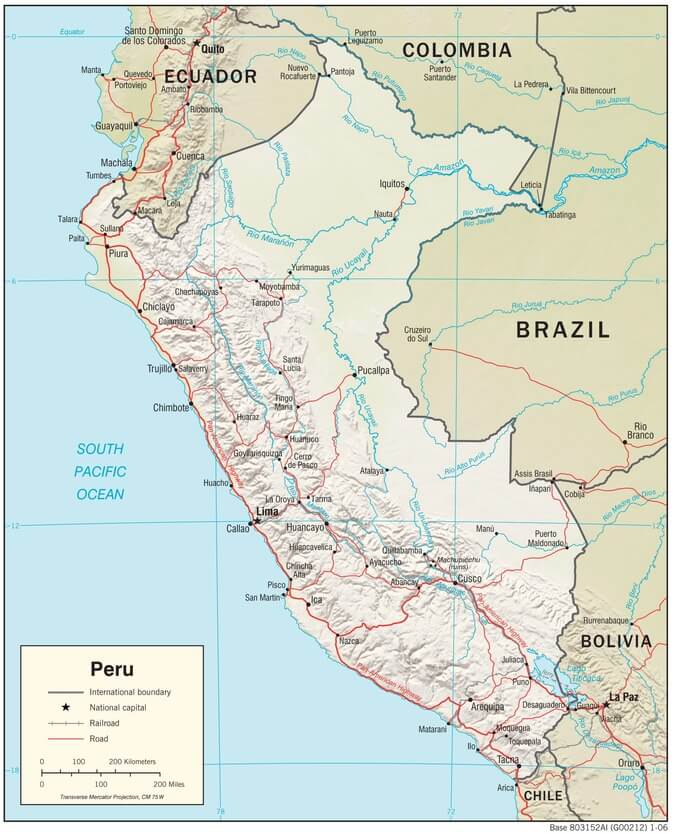
Peru physiographic map.
Notable Dams and Reservoirs
These notable dams and reservoirs in Peru are essential in water management, irrigation, hydroelectric power generation, and overall economic development. They contribute to Peru's agricultural productivity, water supply, and renewable energy production, supporting the needs of communities and industries alike.
Gallito Ciego Dam (Represa Gallito Ciego): Located in the Ica Region, the Gallito Ciego Dam is a critical water storage facility on the Ica River. It plays a crucial role in agriculture irrigation, helping support the region's agricultural activities.
Poechos Dam (Represa de Poechos): Situated in the Piura Region, the Poechos Dam spans the Piura River and forms the Poechos Reservoir. It is a multipurpose project that benefits agriculture and communities by providing irrigation, hydropower generation, and flood control, benefiting agriculture and communities in the region.
Limón Dam (Represa Limón): Located in the Cajamarca Region, the Limón Dam is an important water storage facility on the Jequetepeque River. It regulates the water supply for irrigation and human consumption, contributing to regional development.
Huascacocha Dam (Represa Huascacocha): Located in the Ancash Region, the Huascacocha Dam is part of a hydropower project contributing to Peru's renewable energy production. It harnesses water from the Santa River to generate electricity.
El Fraile Dam (Represa El Fraile): Situated in the Lima Region, the El Fraile Dam is a water storage reservoir on the Rimac River. It provides water for agricultural irrigation and domestic and industrial purposes in the Lima metropolitan area.
Yuracmayo Dam (Represa Yuracmayo): Found in the Junín Region, the Yuracmayo Dam is a multipurpose project that includes water storage for irrigation, hydroelectric power generation, and supply of drinking water to local communities.
Santiago Antúnez de Mayolo Dam (Represa Santiago Antúnez de Mayolo): Located in the Ancash Region, the Santiago Antúnez de Mayolo Dam forms the Huallanca Reservoir. It is an essential component of the Upper Santa River Hydroelectric Complex and helps generate clean energy for the country.
Tablachaca Dam (Represa Tablachaca): Situated in the Ancash Region, the Tablachaca Dam is part of the Tablachaca Hydroelectric Power Plant, which harnesses water from the Santa River to generate electricity.
Tinajones Dam (Represa Tinajones): Found in the Lambayeque Region, the Tinajones Dam is a water storage facility on the Chancay River. It provides water for irrigation in the fertile valleys of northern Peru.
San Lorenzo Dam (Represa San Lorenzo): Located in the Piura Region, the San Lorenzo Dam is a crucial water storage project on the Chira River. It helps regulate the water supply for irrigation and supports agricultural activities in the region.
Cahua Dam (Represa Cahua): Situated in the Huánuco Region, the Cahua Dam forms the Cahua Reservoir, a water supply source for irrigation and potable water in the region.
Upamayo Dam (Represa Upamayo): Found in the Junín Region, the Upamayo Dam is part of the Upamayo Hydroelectric Project. It harnesses water from the Mantaro River to generate electricity.
Notable Rivers
These notable rivers of Peru contribute to the country's ecological diversity, provide essential water resources for various sectors, and play a crucial role in the lives of the people who depend on them for their livelihoods and cultural heritage.
Amazon River (Río Amazonas): The Amazon River is the second-longest river in the world and the largest in discharge volume. It originates in the Andes Mountains of Peru and flows through several South American countries before emptying into the Atlantic Ocean. The Amazon River is the lifeblood of the Amazon rainforest, supporting diverse ecosystems and wildlife, and is crucial for the livelihoods of indigenous communities.
Marañón River (Río Marañón): The Marañón River is one of the main tributaries of the Amazon River and originates in the Peruvian Andes. It flows through rugged canyons and remote landscapes, providing essential water resources to various communities.
Ucayali River (Río Ucayali): Another major tributary of the Amazon, the Ucayali River, also begins in the Peruvian Andes. It merges with the Marañón River to form the main stem of the Amazon River. The Ucayali River is known for its rich biodiversity and is a vital transportation route for local communities.
Huallaga River (Río Huallaga): The Huallaga River rises in Peru's central highlands and flows through the Amazon rainforest. It is a major tributary of the Marañón River and is significant for its role in transportation, agriculture, and hydroelectric power generation.
Mantaro River (Río Mantaro): The Mantaro River is the longest entirely within Peru's borders. It flows through the central Andes and plays a crucial role in irrigation for agricultural purposes. The river is dammed to create reservoirs for hydropower generation, providing a significant portion of Peru's electricity.
Madre de Dios River (Río Madre de Dios): The Madre de Dios River is in southeastern Peru and flows through the Amazon rainforest. It is known for its unique biodiversity and supports various ecosystems, including the Tambopata National Reserve and Manú National Park.
Napo River (Río Napo): The Napo River is a major tributary of the Amazon River and begins its journey in the Andes of Ecuador and Peru. It flows through the rainforest, marking part of Peru's border with Ecuador, and plays a significant role in regional transportation and trade.
Putumayo River (Río Putumayo): The Putumayo River forms part of Peru's border with Colombia. It is a major tributary of the Amazon River and has historical significance as a route for early European explorers venturing into the Amazon basin.
Yavari River (Río Yavari): The Yavari River is a border river between Peru and Brazil. It connects the Madre de Dios River basin to the Amazon River basin and is an essential transportation route for communities in the remote border region.
Pastaza River (Río Pastaza): The Pastaza River originates in the Andes of Ecuador and flows through northern Peru before joining the Marañón River. It is known for its rapid currents and offers opportunities for river rafting and other adventure activities.
Tigre River (Río Tigre): The Tigre River flows through the Peruvian Amazon and is a major tributary of the Marañón River. Lush rainforests surround it and provide habitats for a variety of wildlife species.
Tumbes River (Río Tumbes): The Tumbes River is located in the northernmost region of Peru and forms part of the border with Ecuador. It is a short but essential river that supports agricultural activities in the Tumbes region.
Cañete River (Río Cañete): The Cañete River is located in the Lima Region and is known for its scenic landscapes and opportunities for recreational activities such as fishing and boating.
Zarumilla River (Río Zarumilla): The Zarumilla River forms part of the border between Peru and Ecuador in the northernmost region of Peru. It flows into the Pacific Ocean and is significant for the local agricultural economy.
Chira River (Río Chira): The Chira River is located in the Piura Region of northern Peru and is crucial in irrigating the region's fertile valleys.
Chinchipe River (Río Chinchipe): The Chinchipe River is a major tributary of the Marañón River, originating in the northern highlands of Peru. It is known for its clear waters and scenic landscapes.
Huancabamba River (Río Huancabamba): The Huancabamba River rises in the northern highlands of Peru and flows through the Piura Region. It is a significant water source for agriculture and communities in the region.
Tumbes River (Río Tumbes): The Tumbes River is located in the northernmost region of Peru and forms part of the border with Ecuador. It is a short but essential river that supports agricultural activities in the Tumbes region.
Zarumilla River (Río Zarumilla): The Zarumilla River forms part of the border between Peru and Ecuador in the northernmost region of Peru. It flows into the Pacific Ocean and is significant for the local agricultural economy.
Colca River (Río Colca): The Colca River is significant in southern Peru. It flows through the Colca Canyon, one of the world's deepest canyons. The river's headwaters lie in the Andean mountains, and it runs through the high-altitude landscapes of the Andes before joining the Majes River.
Juruá River (Rio Juruá): The Juruá River is a major river in western South America, flowing through Peru and Brazil. Originating in the Peruvian Andes, it traverses dense rainforests and vast floodplains, eventually joining the Amazon River in Brazil.
Purus River (Río Purús): The Purus River is significant in the Amazon basin, flowing through the remote and pristine rainforests of Peru and Brazil. It originates in the Peruvian Andes and meanders through dense tropical forests, forming an essential part of the Amazon River's intricate network of waterways.
